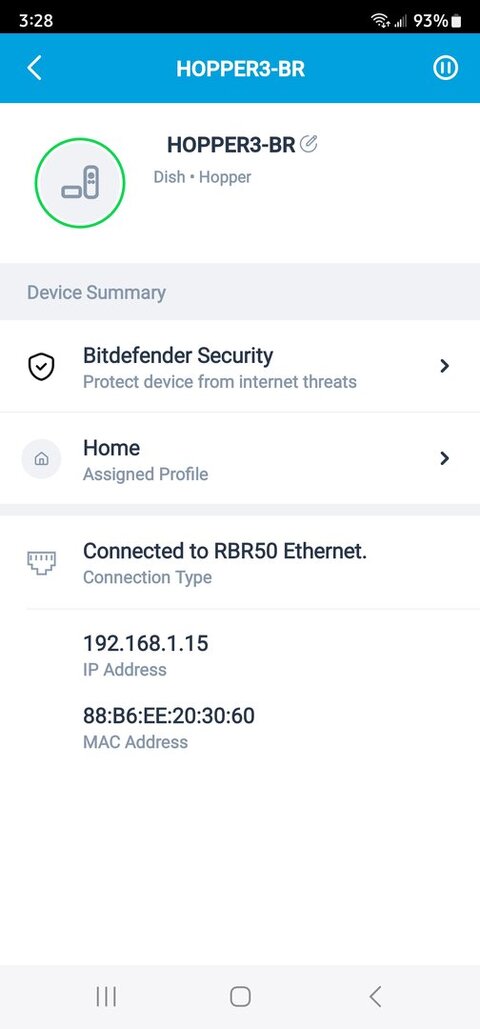I reserve fixed I/P addresses for all the devices on my home network using the device MAC address in my Netgear router.
Living Room Hopper 3 was 192.168.1.6 with MAC address 04:C9 9:A8:2E:C6
9:A8:2E:C6
Family Room Hopper3 moca 192.168.1.17 with MAC address 04:C9 9:E2:96
9:E2:96
Bedroom Joey3 Moca 192.168.1.18 with MAC address 88:B6:EE:13:96:05
Recently I have noticed that my Dish receivers are not using the reserved addresses.
Living Room Hopper3 Ethernet bottom is now 192.168.1.34
The MAC address on the Dish screen is still 04:C9 9:A8:2E:C6
9:A8:2E:C6
But the MAC address in the router is now 88:B6:EE:20:30:62
Family Room Hopper3 moca is now 192.168.1.46
The MAC address on the Dish screen is still 04:C9: 9:9D:E2:96
9:9D:E2:96
But the MAC address in the router is now 88:B6:EE:20:30:60
The bedroom Joey3 Moca stayed at 192.168.1.18 and the Moca address stayed at 88:B6:EE:13:96:05
I have rebooted my Netgear Router and reset the network on all of my Dish devices with no changes.
What is going on? Why is the MAC address in my router different from the actual MAC address shown on the Dish screens?
Everything seems to be working ok with download speeds of 236 Mbps but with all my network devices I prefer to have fixed I/P addresses for all my devices.
Sent from my iPhone using Tapatalk
Living Room Hopper 3 was 192.168.1.6 with MAC address 04:C9
Family Room Hopper3 moca 192.168.1.17 with MAC address 04:C9
Bedroom Joey3 Moca 192.168.1.18 with MAC address 88:B6:EE:13:96:05
Recently I have noticed that my Dish receivers are not using the reserved addresses.
Living Room Hopper3 Ethernet bottom is now 192.168.1.34
The MAC address on the Dish screen is still 04:C9
But the MAC address in the router is now 88:B6:EE:20:30:62
Family Room Hopper3 moca is now 192.168.1.46
The MAC address on the Dish screen is still 04:C9:
But the MAC address in the router is now 88:B6:EE:20:30:60
The bedroom Joey3 Moca stayed at 192.168.1.18 and the Moca address stayed at 88:B6:EE:13:96:05
I have rebooted my Netgear Router and reset the network on all of my Dish devices with no changes.
What is going on? Why is the MAC address in my router different from the actual MAC address shown on the Dish screens?
Everything seems to be working ok with download speeds of 236 Mbps but with all my network devices I prefer to have fixed I/P addresses for all my devices.
Sent from my iPhone using Tapatalk
Last edited:






